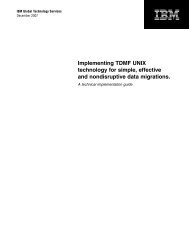Making Connections: Using SOA to enable collaboration in travel - IBM
Making Connections: Using SOA to enable collaboration in travel - IBM
Making Connections: Using SOA to enable collaboration in travel - IBM
Create successful ePaper yourself
Turn your PDF publications into a flip-book with our unique Google optimized e-Paper software.
With an <strong>SOA</strong>-<strong>enable</strong>d system, <strong>in</strong>formation is<br />
available <strong>in</strong> realtime <strong>to</strong> any participat<strong>in</strong>g dest<strong>in</strong>ation<br />
country. By us<strong>in</strong>g the same <strong>in</strong>terfaces<br />
earlier <strong>in</strong> the process, <strong>in</strong>formation can be<br />
analyzed earlier <strong>in</strong> the process. The m<strong>in</strong>ute a<br />
<strong>travel</strong>er <strong>in</strong> the departure country takes a <strong>travel</strong>related<br />
step, the <strong>in</strong>formation can be made<br />
available <strong>to</strong> all potentially <strong>in</strong>terested parties.<br />
The implications for government security and<br />
control, as well as passenger speed and ease,<br />
are significant.<br />
This process occurs <strong>to</strong>day, but us<strong>in</strong>g different<br />
approaches. What is different <strong>in</strong> our recommended<br />
approach is the use of <strong>SOA</strong> <strong>to</strong><br />
<strong>enable</strong> the APA system for realtime access<br />
<strong>to</strong> passenger <strong>in</strong>formation. Exist<strong>in</strong>g electronic<br />
methods of captur<strong>in</strong>g data based on data file<br />
transfers are referred <strong>to</strong> as a “push” model,<br />
where the airl<strong>in</strong>es push the data <strong>to</strong> the dest<strong>in</strong>ation<br />
countries at specific times. These<br />
exist<strong>in</strong>g methods can cont<strong>in</strong>ue. In fact, volume<br />
of flights and passengers would warrant<br />
careful systems analysis dur<strong>in</strong>g the design<br />
process <strong>to</strong> help make sure that both batch<br />
and realtime data exchange is balanced<br />
aga<strong>in</strong>st the ability <strong>to</strong> assess and analyze<br />
the <strong>in</strong>formation. What this solution suggests,<br />
however, is that <strong>SOA</strong> offers an alternative<br />
implementation that provides both the airl<strong>in</strong>es<br />
and the dest<strong>in</strong>ation countries advantages over<br />
the traditional file transfer methods.<br />
Figure 3 shows how <strong>SOA</strong> <strong>in</strong>tegration between<br />
APA systems and other government and<br />
commercial <strong>travel</strong> systems can be implemented.<br />
6 <strong>IBM</strong> Global Bus<strong>in</strong>ess Services<br />
FIGURE 3.<br />
APA system us<strong>in</strong>g <strong>SOA</strong> for <strong>in</strong>tegration with<br />
support<strong>in</strong>g systems.<br />
Airl<strong>in</strong>es<br />
Global<br />
distribution<br />
system<br />
Departure<br />
control<br />
system<br />
Send passenger list<br />
Airl<strong>in</strong>e <strong>in</strong>formation services<br />
• Send passenger list<br />
• Send passenger details<br />
• Send flight <strong>in</strong>formation<br />
• Update flight <strong>in</strong>formation<br />
• Update passenger list<br />
Source: <strong>IBM</strong> Institute for Bus<strong>in</strong>ess Value.<br />
Dest<strong>in</strong>ation country<br />
Government<br />
advance<br />
passenger<br />
analysis<br />
systems<br />
This solution shows the GDS and DCS<br />
systems us<strong>in</strong>g <strong>SOA</strong> services <strong>to</strong> collaborate<br />
with the APA systems <strong>in</strong> the dest<strong>in</strong>ation<br />
country. This <strong>in</strong>terface could be used <strong>in</strong><br />
realtime or batch mode as appropriately determ<strong>in</strong>ed<br />
dur<strong>in</strong>g design. By <strong>in</strong>teract<strong>in</strong>g with the<br />
APA systems us<strong>in</strong>g <strong>SOA</strong> services, however,<br />
<strong>in</strong>formation potentially can be processed as<br />
it arrives, without wait<strong>in</strong>g for data management<br />
and batch w<strong>in</strong>dows <strong>to</strong> load the data. The<br />
realtime nature of <strong>SOA</strong> services provides the<br />
ability <strong>to</strong> see changed <strong>in</strong>formation as soon as<br />
it is provided from the source system.<br />
<strong>SOA</strong> services<br />
This <strong>SOA</strong> option is another implementation<br />
of the “push” model – where data is pushed<br />
from the airl<strong>in</strong>e <strong>to</strong> the dest<strong>in</strong>ation country<br />
system – but with many advantages over<br />
file transfer approaches. For the airl<strong>in</strong>es, file<br />
transfer approaches require software jobs <strong>to</strong><br />
extract the data and additional jobs <strong>to</strong> send.

















